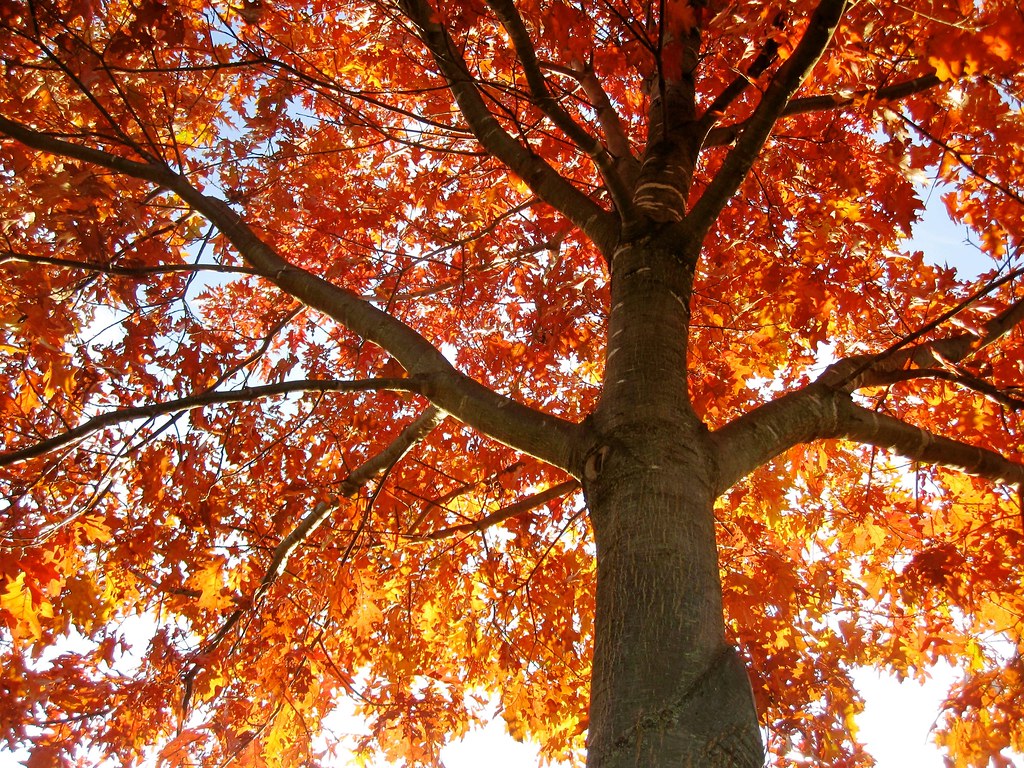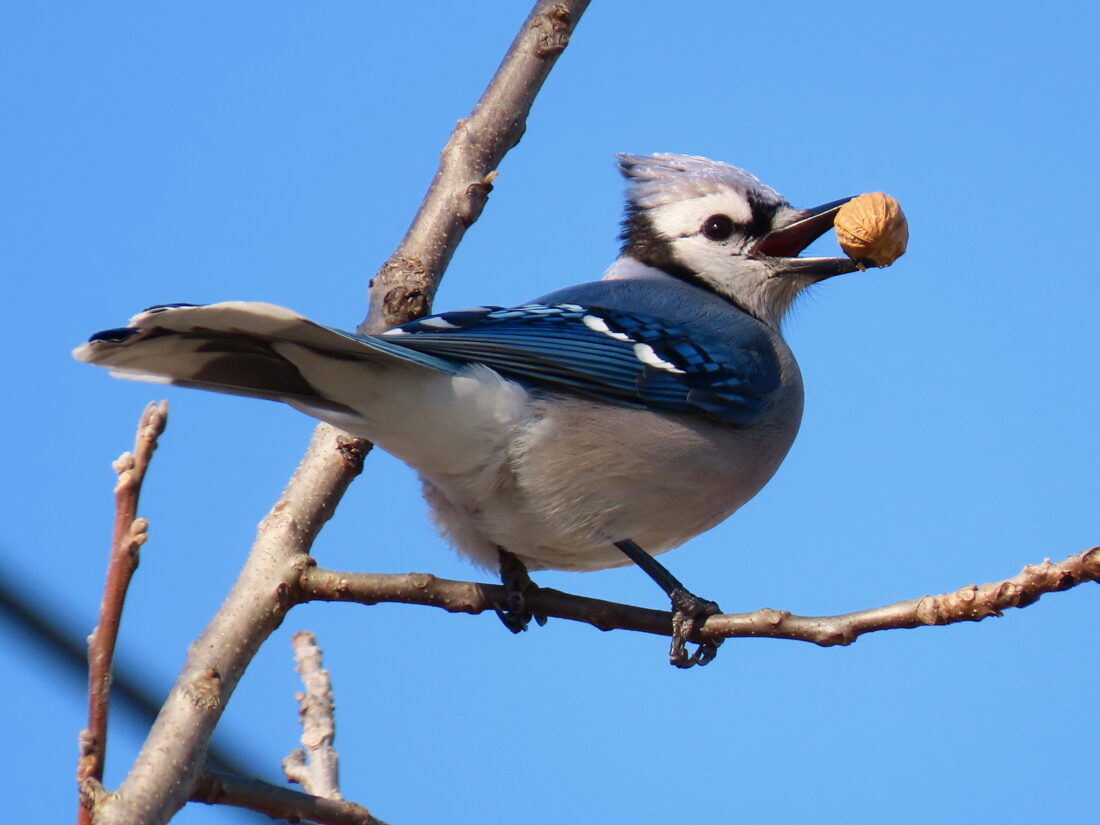Oaks And Jays
- Red Oak glowing in fall light. Photo by Julie Falk
- Fall treasures. Photo by Katie Finch
- Blue Jays eat a wide variety of foods, including walnuts. Photo by Dave Cooney Jr.

Red Oak glowing in fall light. Photo by Julie Falk
A friend once asked for advice about painting a seasonal mural. She wanted to know what plants and animals best represented each season in our region? There are so many options! Evergreens and red cardinals in winter, flowers and frogs for spring, butterflies and bees in summer are just a few that come to mind.
I contemplate this question again, now that we are cycling into fall. Fall brings foggy mornings, with spider webs covered in dew, crisp air threaded with a warm breeze, warm reds, yellows and oranges appearing on the tree covered hillsides. It is a time for harvest, seeds, plump groundhogs and earlier nights. Two things I would definitely recommend she put in the mural for fall are Blue Jays and oak trees.
Blue Jays are a conspicuous and common bird. Their loud, raucous calls are heard in most habitats, including backyard birdfeeders. They are large in size with striking colors and patterns and one of the easiest birds to identify. I have grown accustomed to holding up a picture of this distinctive bird and having 4-year-olds all yell “Blue Jay!” with certainty and joy.
Many of their behaviors, including their ability to dominate a bird feeder, make them unpopular among some bird lovers. However, Blue Jays provide a critical service to our forests through their feeding and storing behavior. For this reason, while they are present in our region in all seasons, I associate them more with fall than any other season. More on Blue Jays in a moment.
The other must-have in a fall mural is an oak tree. There are hundreds of species worldwide. Oaks provide food, shelter, shade and water absorption wherever they are found. Thousands of leaves drop and return nutrients to the soil with the help of bacteria, fungus, other creatures that slowly decompose the leaves. Many oak-loving insects fall from the tree and pupate in the leaf litter below.

Fall treasures. Photo by Katie Finch
In the fall, oaks seeds known as acorns also ripen. In its lifetime, one tree can produce as many as three million acorns – compact packages of carbohydrates, fat, protein that can be eaten but also stored. As food, acorns support dozens of species of wildlife including turkey, deer, squirrels, Wood Ducks, and bears. And Blue Jays!
A squirrel scurrying from under an oak with an acorn in its mouth is a common sight in fall. Finding the partial acorn shell on a log, the insides having been chewed out, is also not unusual. But from the plant’s perspective, why produce a seed that just gets eaten and digested? An acorn has no hard seed that passes through an animal’s digestive system, coming out in its poop. It has no hooks to attack to animal fur or wings to travel on the wind.
Oaks have a different strategy to spread their seeds. They bank on their seeds being stored and forgotten about. Squirrels are often associated with oak trees. And rightly so. Many squirrel species store acorns to eat over the winter. Some of those acorns are never found. The squirrel may forget or get eaten itself. Then the seed has the opportunity to sprout and grow into a new tree. However, the prize for the spreading of acorns goes, not to the squirrel, but to the Blue Jay.
Blue Jays also eat and store acorns for the winter, but in a way that benefits the potential future tree sprouts too. While a squirrel may bury acorns up to 200 feet away from the tree, a Blue Jay can move the acorn up to a mile away. Blue Jays can also carry up to five acorns at time. They carry one in their mouth, one in the tip of their bill and two or three is a specialized pouch in their throat called a gular pouch. They also store one acorn at a time, often in the ground. Is there any better way to plant a tree?
(It is also important to note that “often” is not the same as “always”. I once watched a Blue Jay cache acorns in the thick moss growing on my garage roof. Is there a worse way to plant a tree?)

Blue Jays eat a wide variety of foods, including walnuts. Photo by Dave Cooney Jr.
Blue Jays and oak trees have a well-studied relationship. In one study, six birds with radio transmitters were found to cache 3,000-5,000 acorns each in one fall. Not only do jays have a fondness for acorns, they are also good at sensing which acorns have been infested with weevils and which haven’t. Acorn weevils lay their eggs in the developing acorn and the larva eats the entire flesh of the acorn. In the fall, the weevil emerges through a tiny hole in the acorn, but the acorn will no longer grow. Blue Jays are very good at not storing weevil infested acorns.
Blue Jays inadvertently plant trees that will grow and produce seeds long after they are gone. With the number of acorns Blue Jays cache, they can start a forest in their lifetime. In fact, it is thought that Blue Jays are the reason oak trees spread north so rapidly after the last glacial period.
Blue Jays, which occur across all of eastern and central regions in the United States, are not the only birds that move acorns. Other jay species around the world also spread acorns and other seeds.
In these kinds of relationships, we might wonder who benefits. Is the Blue Jay helping the oak or is the oak helping the Blue Jay? The answer is both – and more. I think we benefit from these mutualistic relationships. We sit under or climb into the branches of an oak tree. We use the wood to create things we need and want. We may even eat the acorns, if you are adventurous in that way. And we get to learn about and witness the amazing way the world works.
Audubon Community Nature Center builds and nurtures connections between people and nature. ACNC is located just east of Route 62 between Warren and Jamestown. The trails are open from dawn to dusk as is Liberty, the Bald Eagle. The Nature Center is open from 10 a.m. until 4:30 p.m. daily except Sunday when it opens at 1 p.m. More information can be found online at auduboncnc.org or by calling 716-569-2345.









